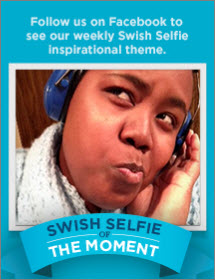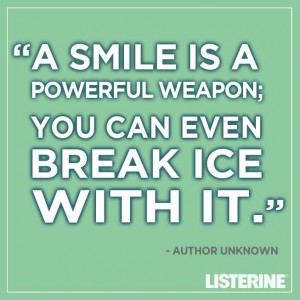Social good campaigns are good for brands. In this post I will share the rationale for this and showcase the Listerine #SwishSelfie Campaign to provide nine tips to maximise success for your brand and the charity.
Social good campaigns, in which a brand uses social media to fundraise and raise awareness for a cause, helps build brand value, develop brand advocates, attract new customers and increase sales. The rationale for this is that research has found that people like to use social media to support causes and they like to encourage their friends to join them. Combine this with the willingness of people to switch brands to support a cause and you have a strategy that is win-win-win. A win for your brand, a win for your charity partner and a win for the participant.
Some key research statistics:
- 57% of Facebook fans surveyed ‘like’ a charity on Facebook because they want to publicly display their support of the non-profit to their friends (Source: Digital Persuasion Report)
- 76% of Facebook fans surveyed agree that its important to them to influence others to care about the charities and causes they care about (Source: Digital Persuasion Report)
- 50% of shopper’s surveyed have made a purchase based on the recommendation of the people they follow (and like) on social networks (Source: The psychology of social commerce)
- Almost ¼ of Australian consumers surveyed switched from their usual product/service to another because of its support of a cause/charity (Source: Charity makes consumers switch brands)
Listerine #SwishSelfie Campaign
 Listerine is hosting #SwishSelfie, a 21 Day Challenge to improve oral health, raise funds for Oral Health America and promote their mouthwash. They created a Facebook competition in which people submit a #SwishSelfie photo using mouthwash. Listerine is donating $5 to Oral Health America for every photo submitted and weekly prizes of $500 for the top selfie. Voters can win prizes too. Now for the 9 tips:
Listerine is hosting #SwishSelfie, a 21 Day Challenge to improve oral health, raise funds for Oral Health America and promote their mouthwash. They created a Facebook competition in which people submit a #SwishSelfie photo using mouthwash. Listerine is donating $5 to Oral Health America for every photo submitted and weekly prizes of $500 for the top selfie. Voters can win prizes too. Now for the 9 tips:
1. Leverage a popular trend
Listerine based the #SwishSelfie campaign on the popularity of “the selfie” in which people take a self portrait photo (typically using a hand-held camera phone) and post it on social media. Other organisations have successfully leveraged the popular trend of posting food images to raise funds and awareness for a cause eg FoodShairFilter for Instagram.
2. Create a campaign #hashtag
Make it short and memorable eg #SwishSelfie.
3. Make the participant the celebrity
 Make the participants a celebrity to increase the chances of campaigns going viral. Showcase their photos and posts. Retweet their tweets. Share and +1 their Google Plus posts.
Make the participants a celebrity to increase the chances of campaigns going viral. Showcase their photos and posts. Retweet their tweets. Share and +1 their Google Plus posts.
Listerine features one person each week on Facebook for their “Swish Selfie of the Moment”. How happy would you be if that was you?
Listerine also engaged a celebrity, Elizabeth Banks, as the face of the campaign, but it’s really not necessary. Having said that, if you can secure the support of a celebrity with huge follower numbers (Elizabeth Banks has 1.4 million followers on Twitter) it will do wonders for boosting your reach. If you do make the celebrity the face of a campaign, try to ensure the campaign image is relevant. For example a Facebook cover photo of Elizabeth Banks doing a “SwishSelfie” would be far more engaging than the current ‘celebrity shot’ (as beautiful as Elizabeth’s white smile is).
4. Partner with a charity that’s a natural fit for the campaign
 Partner with a charity whose mission is in synergy with your brand values and the goals of the campaign. This synergy creates authenticity for the campaign from the viewpoint of your followers, your partner charity’s followers and the public at large.
Partner with a charity whose mission is in synergy with your brand values and the goals of the campaign. This synergy creates authenticity for the campaign from the viewpoint of your followers, your partner charity’s followers and the public at large.
Listerine and Oral Health America both aim to improve oral health so there is a natural fit for the #SwishSelfie campaign.
Plan the campaign together and ensure that both parties are promoting it. That includes liking and sharing Facebook posts, Google Plus posts, retweeting etc. Social good campaigns are about “friendraising” for both parties, as well as fundraising and sales, so ensure that you coordinate your joint campaign to achieve this goal.
It is important to note that at the time of writing #SwishSelfie charity partner Oral Health America are yet to promote the campaign on their website, Facebook or Twitter @Smile4Health.
5. Consider creating a competition
 Competitions increase virality as people encourage their friends to vote for them. Provide a fundraising incentive to encourage people to post images using your product and to vote for their favourite image.
Competitions increase virality as people encourage their friends to vote for them. Provide a fundraising incentive to encourage people to post images using your product and to vote for their favourite image.
The #SwishSelfie campaign is based on a Facebook competition which involves a donation of $5 to Oral Health America for every photo submitted and people are encouraged to vote for their favourite photo. Each week the top voted selfie wins $500 and voters can also win a prize.
It is important to highlight that, unlike with commercial competitions, people participating in social good competitions do not need a personal financial incentive to participate. They will happily submit photos and click/vote to increase donations for a charity. Another great example of a social good campaign asking people to submit photos to help a charity is the Johnson & Johnson Donate A Photo App.
6. Link your campaign to an Awareness Day
Linking your campaign to an awareness day relevant to the cause eg World Health Day or Cancer Awareness Week, will serve to create momentum for your campaign, extend reach and increase awareness for the cause. Remember to use the event #hashtag.
7. Set a donation ceiling
Brands typically donate $1 for each social media post by participants and set a cap. This enables them to run the campaign without worrying that if it goes viral it will blow the budget. Listerine, a global brand, set a limit of $US 64,000. Make sure your limit is prominent on your campaign material.
8. Set a time limit
Setting a short time limit (eg 21 days) for a campaign creates urgency and buzz. However it is important to set enough time to build awareness and momentum for the campaign. For example Listerine set a 21 day challenge as part of the #SwishSelfie campaign, based on the rationale that it takes 21 days to change a habit, however the actual campaign is running for 12 weeks.
9. Use inspirational quotes
 People love sharing inspirational quotes, especially on Facebook. If you’re stuck for quotes, liaise with your charity partner (see Tip 4.) Remember to add your brand name or the campaign to the quote image (in small text).
People love sharing inspirational quotes, especially on Facebook. If you’re stuck for quotes, liaise with your charity partner (see Tip 4.) Remember to add your brand name or the campaign to the quote image (in small text).
About Us: Byron Bay Social Media
Byron Bay Social Media is a social enterprise helping business, nonprofits and government build brand value through social good strategies. If you’re interested in having a chat about how I can help you with your social media strategy, training, policy or other services, please contact me.
If you have extra tips to add or other great examples of brand social good campaigns, please feel free to share them here. Thank you!
Related Articles
- Digital Persuasion: Social Media Motivates People to Contribute Beyond Clicks (csic.georgetown.edu/news)
- The psychology of social commerce (digitalbuzzblog.com)
- Charity makes consumers switch brands (cavil.com.au)
- Foodstagram for a cause (laptopmag.com)
- Donate a photo (donateaphoto.com)
- Harnessing the transformative power of social media for social good (byronbaysocialmedia.net.au)

